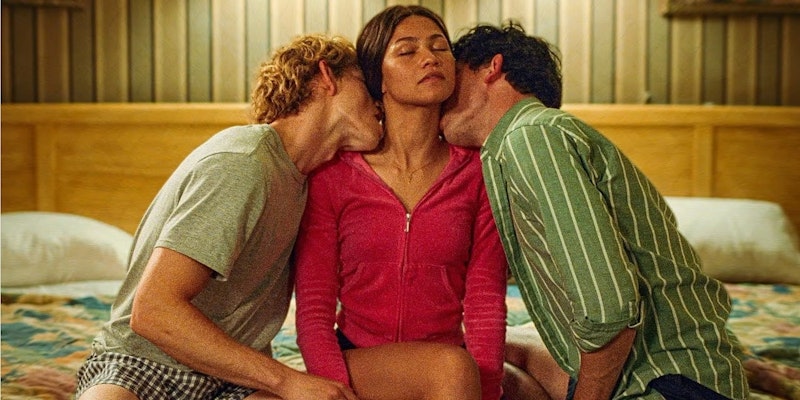Paul Schrader, making movies and writing about movies until he drops dead, had this to say about Challengers (via Facebook): “Zendaya is a star, the movie is stylish and cool why does it need to last 131min? This is at its heart a 100min film. (Dargis references Design for Living in her NYT review, which was 91min long.) The studios would have never let this slight a story run so long—on the other hand, the studios aren’t making this movie anymore.” I agree with him on all points: Luca Guadagnino’s latest is bloated and often unfocused, but it ends powerfully, and all three major players—Zendaya is joined by new faces Mike Faist and Josh O’Connor—are great. Zendaya is supposed to be one of the most popular young American actresses; maybe she is, but will the movie open?
Jerry Seinfeld was made fun of last week for saying that “the movie business is over,” but he’s right, even if he’s promoting a Pop-Tart movie for Netflix. “Film doesn’t occupy the pinnacle in the social, cultural hierarchy that it did for most of our lives… When a movie came out, if it was good, we all went to see it. We all discussed it. We quoted lines and scenes we liked. Now we’re walking through a fire hose of water, just trying to see.” That’s as much the fault of Netflix and the pandemic as the death of celluloid; he went on to speculate that stand-up comedy is more popular than ever right now because “it can’t be faked.” Something was lost when prints disappeared, and at this point, it’s fair to say that digital filmmaking destroyed the movie business as we knew it.
There are still movies. But the studios aren’t making many—and Schrader is right, on the other hand, Challengers is a co-production between MGM and Pascal Pictures. The studios are making this movie, but no one’s coming. I went on opening day, a cold and windy Thursday in late-April just before seven. Maybe not the best time for theater owners. But this was a new movie with, supposedly, one of the most popular stars in the country; besides that, Challengers was about to come out when the SAG-AFTRA strike hit last summer, and there had already been trailers playing promoting a September release—Challengers edged all the way to its release. I saw it at the glorious Senator Theatre here in Baltimore, and there were maybe seven other people at that screening. Challengers cost $55 million—too much, and too long.
Zendaya, Faist, and O’Connor play millennial tennis kids in this threesome period piece, a movie that uses probably two dozen title cards indicating the year, the week, or the time of day. Back and forth, back and forth from 2019 to 2006 to 2009 to 2011 and probably some years I missed in there, but remember: when this movie was shot, Zendaya was 24, Faist was 30, and O’Connor was 32. They are playing high schoolers, and keep in mind these guys are craggy-faced, leading men only in Europe (and O’Connor really is: check out his wonderful work in Alice Rohrwacher’s La Chimera)—but maybe I’m out of touch and that’s in now, just as the notion of a MMF threesome appears to have replaced the FFM threesome in the popular imagination.
Challengers follows them through the years as they flirt, fuck, and eventually fall out: Faist and Zendaya get married and have a kid, while O’Connor is washed up and shooting up, sleeping in his car. She dated O’Connor first, but he fucked up and missed the game where she busted her knee; in comes Faist, and years later, after they’ve started a family, Zendaya’s still hooked on getting these boys to fight over her. Guadagnino isn’t a great director, but he’s compelling—watchable?—and unlike nearly all Hollywood directors, knows how to lust after his actors, men and women. His movies are thoroughly bisexual in a way Schrader only wishes he could conjure—but I’m not sure he was ever interested in pornography. Guadagnino essentially makes softcore genre films, and while the quality varies, there’s something there other than white noise.
But he still can’t cut together a scene to save his life. He uses more shots and setups than any popular director since Paul Greengrass. Guadagnino will have three people talking and use two dozen setups, cutting between angles constantly, without any rhythm. It’s haphazard and serves zero purpose—he even returns to previous setups, destroying any momentum that could come from a scene that never repeats setups (Michelangelo Antonioni and William Friedkin often did this). Like the music, the cuts are deployed randomly, and it only works because the movie’s raw material is good enough, and that ending does wrap it up with a fine orgasm, just enough to make up for that extra half hour that Schrader wishes wasn’t there. It shouldn’t: Challengers should be shorter, but that’s not what’ll hurt it at the box office. I just wonder how many people even know this movie exists.
—Follow Nicky Otis Smith on Twitter and Instagram: @nickyotissmith

